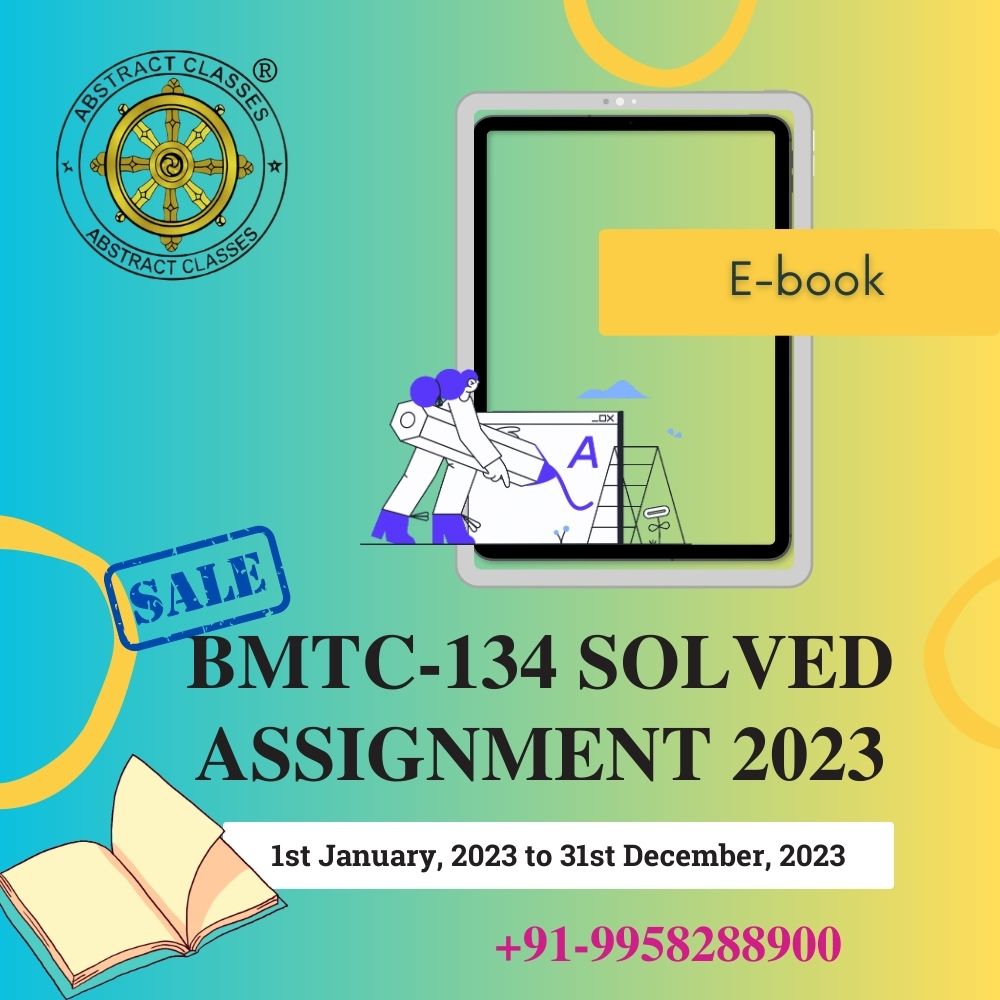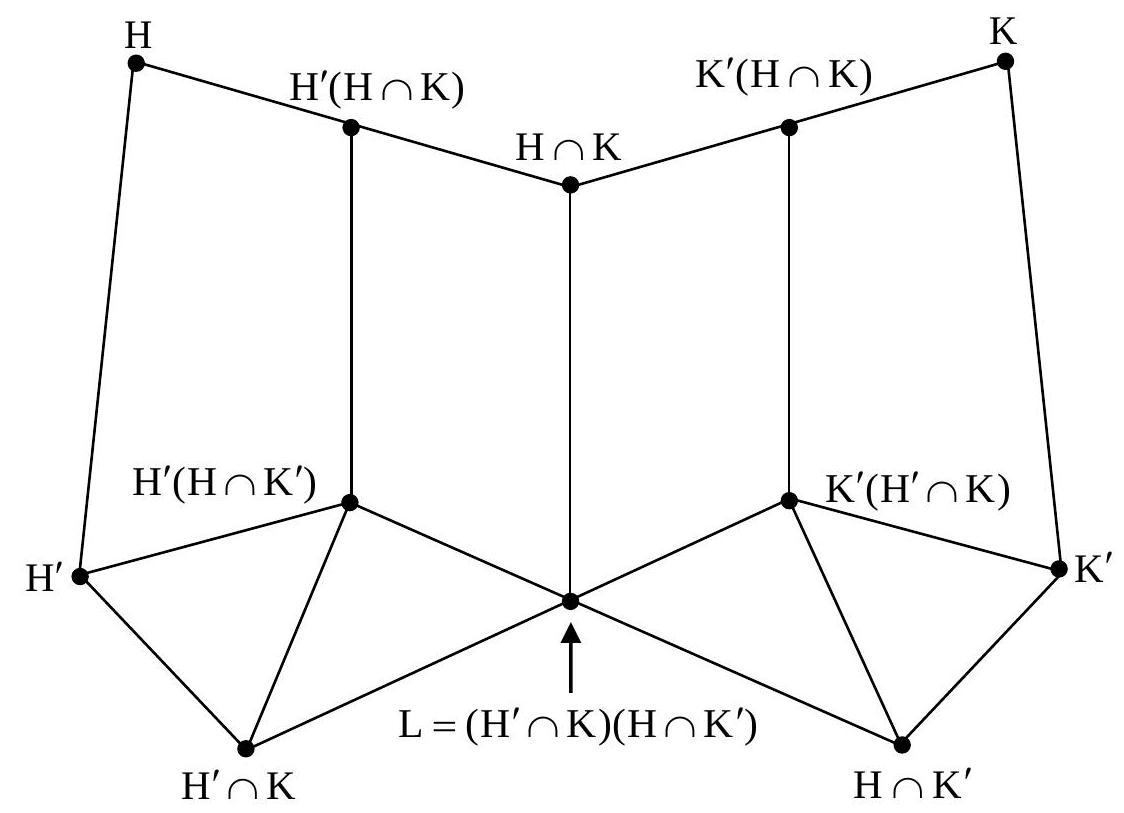
IGNOU BMTC-134 Solved Assignment 2023 | B.Sc (G) CBCS
₹101.00
Please read the following points before ordering this IGNOU Assignment Solution.
Share with your Friends
IGNOU BMTC-134 Assignment Question Paper 2023
Course Code: BMTC-134
Assignment Code: BMTC-134/TMA/2023
Maximum Marks: 100
\section{PART-A (MM: 50 Marks)}
(To be done after studying Blocks 1 and 2.)
1. Which of the following statements are true? Give reasons for your answers.
i) If a group \(G\) is isomorphic to one of its proper subgroups, then \(G=\mathbb{Z}\).
ii) If \(\mathrm{x}\) and \(\mathrm{y}\) are elements of a non-abelian group \((\mathrm{G}, *)\) such that \(\mathrm{x} * \mathrm{y}=\mathrm{y} * \mathrm{x}\), then \(\mathrm{x}=\mathrm{e}\) or \(\mathrm{y}=\mathrm{e}\), where \(\mathrm{e}\) is the identity of \(\mathrm{G}\) with respect to \(*\).
iii) There exists a unique non-abelian group of prime order.
iv) If \((a, b) \in A \times A\), where \(A\) is a group, then \(o((a, b))=o(a) o(b)\).
v) If \(\mathrm{H}\) and \(\mathrm{K}\) are normal subgroups of a group \(\mathrm{G}\), then \(h k=k h \forall \mathrm{h} \in \mathrm{H}, \mathrm{k} \in \mathrm{K}\).
2. a) Prove that every non-trivial subgroup of a cyclic group has finite index. Hence prove that \((\mathbb{Q},+)\) is not cyclic.
b) Let \(\mathrm{G}\) be an infinite group such that for any non-trivial subgroup \(\mathrm{H}\) of \(G,|G: H|<\infty\). Then prove that
i) \(\mathrm{H} \leq \mathrm{G} \Rightarrow \mathrm{H}=\{\mathrm{e}\}\) or \(\mathrm{H}\) is infinite;
ii) If \(g \in G, g \neq e\), then \(o(g)\) is infinite.
c) Prove that a cyclic group with only one generator can have at most 2 elements.
3. a) Using Cayley’s theorem, find the permutation group to which a cyclic group of order 12 is isomorphic.
b) Let \(\tau\) be a fixed odd permutation in \(\mathrm{S}_{10}\). Show that every odd permutation in \(\mathrm{S}_{10}\) is a product of \(\tau\) and some permutation in \(\mathrm{A}_{10}\).
c) List two distinct cosets of \(\langle\mathrm{r}\rangle\) in \(\mathrm{D}_{10}\), where \(\mathrm{r}\) is a reflection in \(\mathrm{D}_{10}\).
d) Give the smallest \(n \in \mathbb{N}\) for which \(A_{n}\) is non-abelian. Justify your answer.
4. Use the Fundamental Theorem of Homomorphism for Groups to prove the following theorem, which is called the Zassenhaus (Butterfly) Lemma:
Let \(\mathrm{H}\) and \(\mathrm{K}\) be subgroups of a group \(\mathrm{G}\) and \(\mathrm{H}^{\prime}\) and \(\mathrm{K}^{\prime}\) be normal subgroups of \(\mathrm{H}\) and K, respectively. Then
i) \(\mathrm{H}^{\prime}\left(\mathrm{H} \cap \mathrm{K}^{\prime}\right) \triangleleft \mathrm{H}^{\prime}(\mathrm{H} \cap \mathrm{K})\)
ii) \(\mathrm{K}^{\prime}\left(\mathrm{H}^{\prime} \cap \mathrm{K}\right) \triangleleft \mathrm{K}^{\prime}(\mathrm{H} \cap \mathrm{K})\) iii) \(\frac{\mathrm{H}^{\prime}(\mathrm{H} \cap \mathrm{K})}{\mathrm{H}^{\prime}\left(\mathrm{H} \cap \mathrm{K}^{\prime}\right)} \simeq \frac{\mathrm{K}^{\prime}(\mathrm{H} \cap \mathrm{K})}{\mathrm{K}^{\prime}\left(\mathrm{H}^{\prime} \cap \mathrm{K}\right)} \simeq \frac{(\mathrm{H} \cap \mathrm{K})}{\left(\mathrm{H}^{\prime} \cap \mathrm{K}\right)\left(\mathrm{H} \cap \mathrm{K}^{\prime}\right)}\)
The situation can be represented by the subgroup diagram below, which explains the name ‘butterfly’.

\section{PART-B (MM: 30 Marks)}
(Based on Block 3.)
5. Which of the following statements are true, and which are false? Give reasons for your answers.
i) For any ring \(R\) and \(a, b \in R,(a+b)^{2}=a^{2}+2 a b+b^{2}\).
ii) Every ring has at least two elements.
iii) If \(\mathrm{R}\) is a ring with identity and \(\mathrm{I}\) is an ideal of \(\mathrm{R}\), then the identity of \(\mathrm{R} / \mathrm{I}\) is the same as the identity of \(\mathrm{R}\).
iv) If \(\mathrm{f}: \mathrm{R} \rightarrow \mathrm{S}\) is a ring homomorphism, then it is a group homomorphism from \((\mathrm{R},+)\) to \((\mathrm{S},+)\).
v) If \(\mathrm{R}\) is a ring, then any ring homomorphism from \(\mathrm{R} \times \mathrm{R}\) into \(\mathrm{R}\) is surjective.
6. a) For an ideal I of a commutative ring \(\mathrm{R}\), define \(\sqrt{\mathrm{I}}=\left\{\mathrm{x} \in \mathrm{R} \mid \mathrm{x}^{\mathrm{n}} \in \mathrm{I}\right.\) for some \(\left.\mathrm{n} \in \mathbb{N}\right\}\). Show that
i) \(\sqrt{\mathrm{I}}\) is an ideal of \(\mathrm{R}\).
ii) \(\mathrm{I} \subseteq \sqrt{\mathrm{I}}\).
iii) \(\mathrm{I} \neq \sqrt{\mathrm{I}}\) in some cases.
b) Is \(\frac{R}{\mathrm{I}} \times \frac{\mathrm{R}}{\mathrm{J}} \simeq \frac{\mathrm{R} \times \mathrm{R}}{\mathrm{I} \times \mathrm{J}}\), for any two ideals \(\mathrm{I}\) and \(\mathrm{J}\) of a ring \(\mathrm{R}\) ? Give reasons for your answer. 7. Let \(\mathrm{S}\) be a set, \(\mathrm{R}\) a ring and \(\mathrm{f}\) be a 1-1 mapping of \(\mathrm{S}\) onto \(\mathrm{R}\). Define + and \(\cdot\) on \(\mathrm{S}\) by: \(\left.x+y=f^{-1}(f(x))+f(y)\right)\)
\(x \cdot y=f^{-1}(f(x) \cdot f(y))\)
\(\forall \mathrm{x}, \mathrm{y} \in \mathrm{S}\).
Show that \((\mathrm{S},+, \cdot)\) is a ring isomorphic to \(\mathrm{R}\).
\section{PART-C (MM: 20 Marks)}
(Based on Block 4.)
8. Which of the following statements are true, and which are false? Give reasons for your answers.
i) If \(\mathrm{k}\) is a field, then so is \(\mathrm{k} \times \mathrm{k}\).
ii) If \(\mathrm{R}\) is an integral domain and \(\mathrm{I}\) is an ideal of \(\mathrm{R}\), then Char (R)= Char (R/I).
iii) In a domain, every prime ideal is a maximal ideal.
iv) If \(\mathrm{R}\) is a ring with zero divisors, and \(\mathrm{S}\) is a subring of \(\mathrm{R}\), then \(\mathrm{S}\) has zero divisors.
v) If \(R\) is a ring and \(f(x) \in R[x]\) is of degree \(n \in \mathbb{N}\), then \(f(x)\) has exactly roots in \(\mathrm{R}\).
9. a) Find all the units of \(\mathbb{Z}[\sqrt{-7}]\).
b) Check whether or not \(\mathbb{Q}[x] /<8 x^{3}+6 x^{2}-9 x+24>\) is a field.
c) Construct a field with 125 elements.
BMTC-134 Sample Solution 2023
Frequently Asked Questions (FAQs)
You can access the Complete Solution through our app, which can be downloaded using this link:
Simply click “Install” to download and install the app, and then follow the instructions to purchase the required assignment solution. Currently, the app is only available for Android devices. We are working on making the app available for iOS in the future, but it is not currently available for iOS devices.
Yes, It is Complete Solution, a comprehensive solution to the assignments for IGNOU. Valid from January 1, 2023 to December 31, 2023.
Yes, the Complete Solution is aligned with the IGNOU requirements and has been solved accordingly.
Yes, the Complete Solution is guaranteed to be error-free.The solutions are thoroughly researched and verified by subject matter experts to ensure their accuracy.
As of now, you have access to the Complete Solution for a period of 6 months after the date of purchase, which is sufficient to complete the assignment. However, we can extend the access period upon request. You can access the solution anytime through our app.
The app provides complete solutions for all assignment questions. If you still need help, you can contact the support team for assistance at Whatsapp +91-9958288900
No, access to the educational materials is limited to one device only, where you have first logged in. Logging in on multiple devices is not allowed and may result in the revocation of access to the educational materials.
Payments can be made through various secure online payment methods available in the app.Your payment information is protected with industry-standard security measures to ensure its confidentiality and safety. You will receive a receipt for your payment through email or within the app, depending on your preference.
The instructions for formatting your assignments are detailed in the Assignment Booklet, which includes details on paper size, margins, precision, and submission requirements. It is important to strictly follow these instructions to facilitate evaluation and avoid delays.
Terms and Conditions
- The educational materials provided in the app are the sole property of the app owner and are protected by copyright laws.
- Reproduction, distribution, or sale of the educational materials without prior written consent from the app owner is strictly prohibited and may result in legal consequences.
- Any attempt to modify, alter, or use the educational materials for commercial purposes is strictly prohibited.
- The app owner reserves the right to revoke access to the educational materials at any time without notice for any violation of these terms and conditions.
- The app owner is not responsible for any damages or losses resulting from the use of the educational materials.
- The app owner reserves the right to modify these terms and conditions at any time without notice.
- By accessing and using the app, you agree to abide by these terms and conditions.
- Access to the educational materials is limited to one device only. Logging in to the app on multiple devices is not allowed and may result in the revocation of access to the educational materials.
Our educational materials are solely available on our website and application only. Users and students can report the dealing or selling of the copied version of our educational materials by any third party at our email address (abstract4math@gmail.com) or mobile no. (+91-9958288900).
In return, such users/students can expect free our educational materials/assignments and other benefits as a bonafide gesture which will be completely dependent upon our discretion.
Related products
-
IGNOU Assignment Solution
IGNOU MEG-17 Solved Assignment 2022-2023 | MEG | American Drama
₹101.00 Go to the App -
IGNOU Assignment Solution
IGNOU MEG-12 Solved Assignment 2022-2023 | MEG | A Survey Course in 20th Century Canadian Literature
₹101.00 Go to the App -
IGNOU Assignment Solution
IGNOU MEG-03 Solved Assignment 2022-2023 | MEG | British Novel
₹101.00 Go to the App






